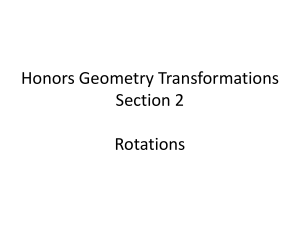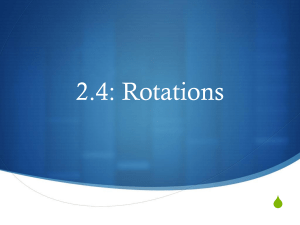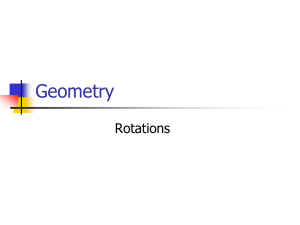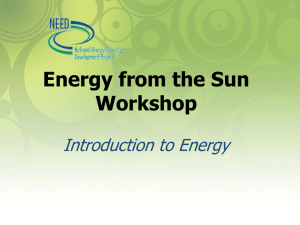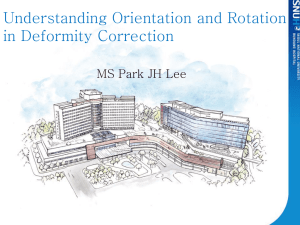Rotations
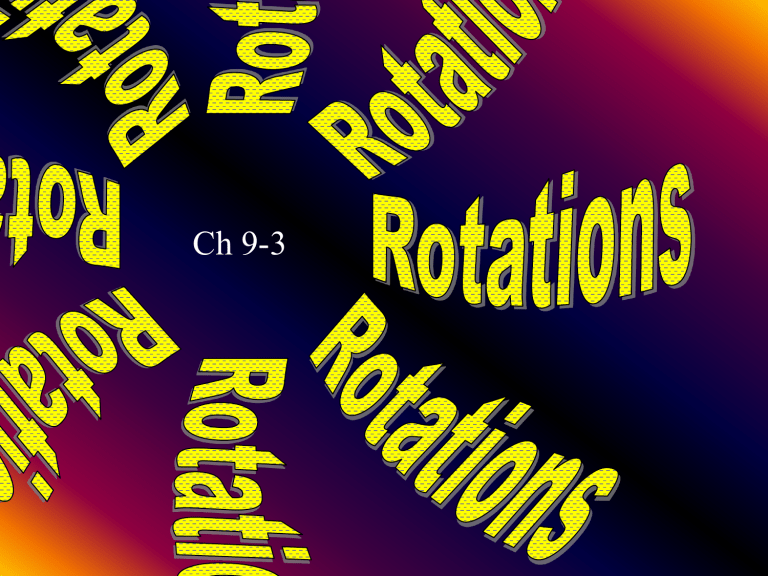
Ch 9-3
• Draw rotated images using the angle of rotation.
• Identify figures with rotational symmetry.
• rotation
• center of rotation
• angle of rotation
• rotational symmetry
• invariant points
• direct isometry
• indirect isometry
Rotations
A transformation in which a figure is turned about a fixed point.
The fixed point is the Center of Rotation
Rays drawn from the center of rotation to a point and its image form an angle called the
Angle of Rotation.
Watch when this rectangle is rotated by a given angle measure.
Center of
Rotation
Hi
Center of
Rotation
Hi
Angle of
Rotation
A. For the following diagram, which description best identifies the rotation of triangle ABC around point Q?
A.
20 ° clockwise
B.
20 ° counterclockwise
C.
90 ° clockwise
D.
90 ° counterclockwise
0% 0% 0% 0%
A.
A
B.
B
C.
C
D.
D
A B C D
Rotations
• A composite of two reflections over two intersecting lines
• The angle of rotation is twice the measure of the angle b/t the two lines of reflection
• Coordinate Plane rotation
Rotating about the origin
Reflections in Intersecting Lines
Find the image of parallelogram WXYZ under reflections in line p and then line q.
First reflect parallelogram
WXYZ in line p . Then label the image W'X'Y'Z' .
Next, reflect the image in line q .
Then label the image W''X''Y''Z'' .
Answer: Parallelogram W''X''Y''Z'' is the image of parallelogram WXYZ under reflections in line p and q .
In the following diagram, which triangle is the image of ΔABC under reflections in line m and then line n.
A.
blue Δ
B.
green Δ
C.
neither
1.
2.
3.
A
B
C
A
0% 0%
B
0%
C
Coordinate Plane Rotation
Rotating about the origin
• Clockwise vs.Counterclockwise
• 90 o
Quarter turn
• 180 o
Half turn
(clockwise or counterclockwise)
• 270 o
Three quarter turn
Big Hint!!!
If you need to rotate a shape about the origin,
• TURN THE PAPER
• Write down the new coordinates
• Turn the paper back and graph the rotated points.
Example #1
• Rotate
ABC 90 o clockwise about the origin.
Turn the paper
A’
(90 o clockwise)
B
4
Write the new coordinates
A’ (2, 4)
-5
A C’
2
B’
B’ (4, 1)
C’ (-1, 3)
C
-2
5
Turn the paper back and graph the rotated points
Example #2
• Rotate
ABC 180 o about the origin.
Turn the paper
(180 o )
B
4
Write the new coordinates
A’ (4, -2)
B’ (1, -4)
C’ (3, 1)
-5
A
C
2
-2
-4
B’
Turn the paper back and graph the rotated points
C’
A’
5
Rotational Symmetry
• A figure has rotational symmetry if it can be mapped onto itself by a rotation of 180º or less.
– Equilateral Triangle
– Square
– Most regular polygons
A B
D C
There are 3 rotations (<360 degrees) where the triangle maps onto itself.
The equilateral triangle has rotational symmetry of order = 3.
360
3
120
magnitude of symmetry
An equilateral triangle maps onto itself every 120 degrees of rotation.
An regular pentagon has an order of 5.
5
4
1
3
2
360
5
72
magnitude of symmetry
5
4
1
3
2
Draw a Rotation
A. Rotate quadrilateral RSTV 45 ° counterclockwise about point A.
• Draw a segment from point R to point A .
• Use a protractor to measure a
45 ° angle counterclockwise with as one side. Extend the other side to be longer than AR.
• Locate point R ' so that AR = AR'.
• Repeat this process for points S,
T, and V.
• Connect the four points to form
R'S'T'V'.
Draw a Rotation
Quadrilateral R'S'T'V' is the image of quadrilateral
RSTV under a 45 ° counterclockwise rotation about point A .
Answer:
Draw a Rotation
B. Triangle DEF has vertices D( –2, –1), E(–1, 1), and
F(1, –1). Draw the image of DEF under a rotation of
115 ° clockwise about the point G(–4, –2).
First draw Δ DEF and plot point G .
Draw a segment from point G to point D .
Use a protractor to measure a 115 ° angle clockwise with as one side.
Draw
Use a compass to copy onto
Name the segment
Repeat with points E and F .
Draw a Rotation
Δ D'E'F' is the image of Δ DEF under a 115 ° clockwise rotation about point G .
Answer:
B. Triangle ABC has vertices A(1, –2), B(4, –6), and
C(1, –6). Draw the image of ΔABC under a rotation of
70 ° counterclockwise about the point M(–1, –1).
A.
B.
C.
D.
A
A.
A
0%
B.
0%
B
C B C.
C
D.
D
0%
D
